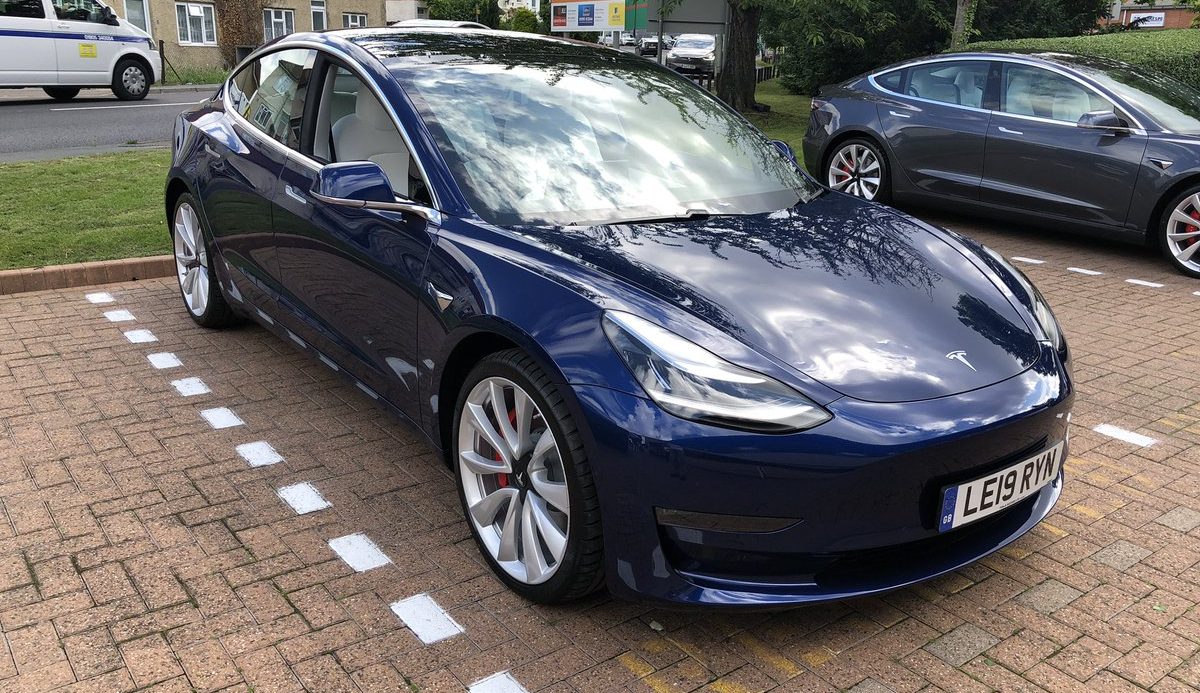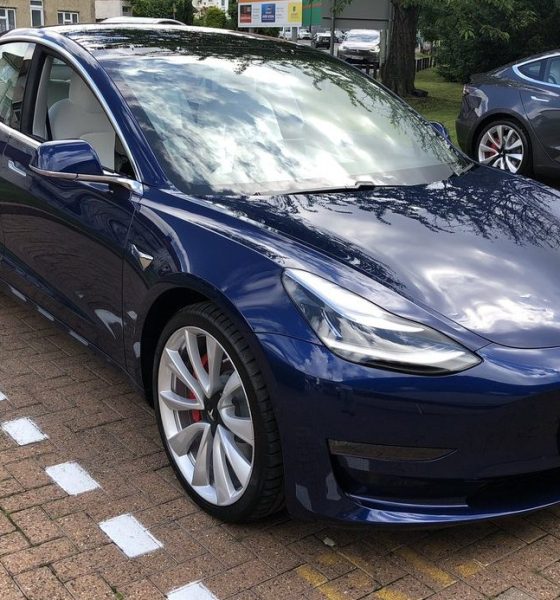

News
Tesla Model 3 to be among the UK’s best company cars amid EV-friendly policy update
In what could only be described as a “milestone moment,” the UK Treasury has confirmed that employees who drive zero-emission company cars will pay no benefit-in-kind (BIK) tax for the year. This decision heavily incentivizes businesses to purchase electric vehicles for their fleets, which contribute to nearly six out of ten new car registrations in the UK today.
Under the updated rules from the government, those who choose zero-emission vehicles will pay no company car tax for the year from April 2020, followed by a measly 1% tax from April 2021 and 2% BIK from April 2022. This is in stark contrast to the BIK taxes placed on vehicles equipped with the internal combustion engine. A BMW 3-Series with a 2.0-liter diesel engine, for example, is priced at £32,000 (~$40,200). But due to its CO2 emissions of 110 and 115g/km, the vehicle will be subject to a 31% BIK rate from April 2020.
Considering that the UK’s personal income tax rates can hit 40% for taxpayers earning £50,001 (~$62,000) to £150,000 (~$188,500) per year, those under the income bracket would pay £4,000 (~$5,000) in BIK just for using the diesel-powered BMW 3-Series from April 2020 and March 2021. Taxpayers in the same income bracket that drive a Tesla Model 3, on the other hand, would pay no BIK for the same period. The 1% tax and 2% BIK that follows in the next two years are also marginal.
In a statement, the government noted that the regulations are expected to encourage businesses to make informed decisions about their purchase of fleet vehicles. “By providing clarity of future the appropriate percentages, businesses will have the ability to make more informed decisions about how they make the transition to zero-emission fleets. Appropriate percentages beyond 2022-23 remain under review and will be announced at future fiscal events,” the government stated.
It’s not just all-electric vehicles like the Tesla Model 3 that will benefit significantly from the UK’s updated policies. Plug-in hybrids could also take advantage of the government’s zero company car tax rate, provided that the PHEVs are capable of operating at least 130 miles as a pure electric car. Unfortunately, there are no PHEVs in the market today that meets this metric. This is quite ironic since BMW director of development Klaus Frölich recently stated that the carmaker is focusing its efforts in developing PHEVs with only 80 km (49 miles) of pure electric range. “PHEV gives them full freedom and 80 km of EV range,” he said.
Plug-in hybrids with short electric ranges, such as those mentioned by the BMW executive, will still see tax breaks, though they are notably less generous than those granted to all-electric cars. PHEVs that have less than 30 miles of electric range, such as the BMW 225xe Active Tourer, will be subject to a 12% BIK tax from April next year.
With these new regulations in place, the Tesla Model 3 has the potential to become one of the most competitive company vehicles in the UK. The car, after all, boasts 240 miles of range even at its Standard Plus variant, and it comes from a company that competes in the premium segment. Considering that company cars used by middle-level to upper-level employees are usually premium vehicles, Tesla’s midsize sedan might prove to be a perfect fit.
The turnover rates for company vehicles in the UK is quite quick, with approximately 300k-500k company cars coming off lease every year. If Tesla could tap into this market with the Model 3, the company could have a steady stream of EV buyers that will likely keep the demand for the vehicle thriving in the region for a considerable length of time. The UK’s company car market is now ripe for the picking for EV makers, and if Tesla plays its cards right, it could very well be on the lead to take the first bite.

News
Tesla FSD fleet is nearing 7 billion total miles, including 2.5 billion city miles
As can be seen on Tesla’s official FSD webpage, vehicles equipped with the system have now navigated over 6.99 billion miles.

Tesla’s Full Self-Driving (Supervised) fleet is closing in on almost 7 billion total miles driven, as per data posted by the company on its official FSD webpage.
These figures hint at the massive scale of data fueling Tesla’s rapid FSD improvements, which have been quite notable as of late.
FSD mileage milestones
As can be seen on Tesla’s official FSD webpage, vehicles equipped with the system have now navigated over 6.99 billion miles. Tesla owner and avid FSD tester Whole Mars Catalog also shared a screenshot indicating that from the nearly 7 billion miles traveled by the FSD fleet, more than 2.5 billion miles were driven inside cities.
City miles are particularly valuable for complex urban scenarios like unprotected turns, pedestrian interactions, and traffic lights. This is also the difference-maker for FSD, as only complex solutions, such as Waymo’s self-driving taxis, operate similarly on inner-city streets. And even then, incidents such as the San Francisco blackouts have proven challenging for sensor-rich vehicles like Waymos.
Tesla’s data edge
Tesla has a number of advantages in the autonomous vehicle sector, one of which is the size of its fleet and the number of vehicles training FSD on real-world roads. Tesla’s nearly 7 billion FSD miles then allow the company to roll out updates that make its vehicles behave like they are being driven by experienced drivers, even if they are operating on their own.
So notable are Tesla’s improvements to FSD that NVIDIA Director of Robotics Jim Fan, after experiencing FSD v14, noted that the system is the first AI that passes what he described as a “Physical Turing Test.”
“Despite knowing exactly how robot learning works, I still find it magical watching the steering wheel turn by itself. First it feels surreal, next it becomes routine. Then, like the smartphone, taking it away actively hurts. This is how humanity gets rewired and glued to god-like technologies,” Fan wrote in a post on X.
News
Tesla starts showing how FSD will change lives in Europe
Local officials tested the system on narrow country roads and were impressed by FSD’s smooth, human-like driving, with some calling the service a game-changer for everyday life in areas that are far from urban centers.

Tesla has launched Europe’s first public shuttle service using Full Self-Driving (Supervised) in the rural Eifelkreis Bitburg-Prüm region of Germany, demonstrating how the technology can restore independence and mobility for people who struggle with limited transport options.
Local officials tested the system on narrow country roads and were impressed by FSD’s smooth, human-like driving, with some calling the service a game-changer for everyday life in areas that are far from urban centers.
Officials see real impact on rural residents
Arzfeld Mayor Johannes Kuhl and District Administrator Andreas Kruppert personally tested the Tesla shuttle service. This allowed them to see just how well FSD navigated winding lanes and rural roads confidently. Kruppert said, “Autonomous driving sounds like science fiction to many, but we simply see here that it works totally well in rural regions too.” Kuhl, for his part, also noted that FSD “feels like a very experienced driver.”
The pilot complements the area’s “Citizen Bus” program, which provides on-demand rides for elderly residents who can no longer drive themselves. Tesla Europe shared a video of a demonstration of the service, highlighting how FSD gives people their freedom back, even in places where public transport is not as prevalent.
What the Ministry for Economic Affairs and Transport says
Rhineland-Palatinate’s Minister Daniela Schmitt supported the project, praising the collaboration that made this “first of its kind in Europe” possible. As per the ministry, the rural rollout for the service shows FSD’s potential beyond major cities, and it delivers tangible benefits like grocery runs, doctor visits, and social connections for isolated residents.
“Reliable and flexible mobility is especially vital in rural areas. With the launch of a shuttle service using self-driving vehicles (FSD supervised) by Tesla in the Eifelkreis Bitburg-Prüm, an innovative pilot project is now getting underway that complements local community bus services. It is the first project of its kind in Europe.
“The result is a real gain for rural mobility: greater accessibility, more flexibility and tangible benefits for everyday life. A strong signal for innovation, cooperation and future-oriented mobility beyond urban centers,” the ministry wrote in a LinkedIn post.
News
Tesla China quietly posts Robotaxi-related job listing
Tesla China is currently seeking a Low Voltage Electrical Engineer to work on circuit board design for the company’s autonomous vehicles.

Tesla has posted a new job listing in Shanghai explicitly tied to its Robotaxi program, fueling speculation that the company is preparing to launch its dedicated autonomous ride-hailing service in China.
As noted in the listing, Tesla China is currently seeking a Low Voltage Electrical Engineer to work on circuit board design for the company’s autonomous vehicles.
Robotaxi-specific role
The listing, which was shared on social media platform X by industry watcher @tslaming, suggested that Tesla China is looking to fill the role urgently. The job listing itself specifically mentions that the person hired for the role will be working on the Low Voltage Hardware team, which would design the circuit boards that would serve as the nervous system of the Robotaxi.
Key tasks for the role, as indicated in the job listing, include collaboration with PCB layout, firmware, mechanical, program management, and validation teams, among other responsibilities. The role is based in Shanghai.
China Robotaxi launch
China represents a massive potential market for robotaxis, with its dense urban centers and supportive policies in select cities. Tesla has limited permission to roll out FSD in the country, though despite this, its vehicles have been hailed as among the best in the market when it comes to autonomous features. So far, at least, it appears that China supports Tesla’s FSD and Robotaxi rollout.
This was hinted at in November, when Tesla brought the Cybercab to the 8th China International Import Expo (CIIE) in Shanghai, marking the first time that the autonomous two-seater was brought to the Asia-Pacific region. The vehicle, despite not having a release date in China, received a significant amount of interest among the event’s attendees.








